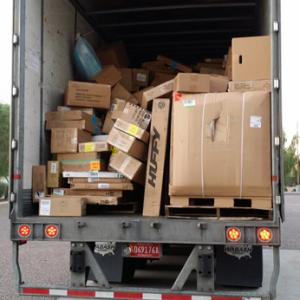
No one who utilizes freight carriers is immune to the possibility of freight damage. While it may be impossible to control damage-inducing events such as natural disasters, there are measures that can be taken to help lessen the negative impact of freight damage. If damage is suspected, there are steps that should be followed to help ensure that damaged goods are replaced or that reimbursement is provided.
A number of factors can contribute to the likelihood of freight damage. The most common contributors include the warehousing conditions of the shipper and receiver, the presence of special loading requirements, the way the freight is packed on a truck, and adverse weather conditions. Freight damage is typically sustained after goods have been collected from the company of origin but before the goods arrive at their destination.
The single most important step that you should follow in the damage-control process is to ensure that all parcels and loads are thoroughly inspected before providing a signature for the truck driver. If you are unable to personally inspect the delivered goods, then the individual(s) who will be receiving the goods should be instructed to carefully inspect each parcel or container. It is important that receiving staff are advised to never assume that the goods within a crate or other parcel are intact simply because there is no apparent damage to the exterior surface of the parcel.
If damage is detected during the inspection process, the details of the damage should be noted on the shipping paperwork that is provided to you by the driver. It is very important to be as specific as possible when you document the damage sustained to the goods. For instance, if five damaged parcels are delivered but you only reference damage to one parcel, then this reduces the likelihood that you will receive a refund or that the purchased goods will be replaced at no cost. Additionally, rather than simply stating, “Shipment incomplete”, it would be more advisable to state, “Five parcels were ordered and shipped but only three were received.” It is always better to be a bit excessive in your description as opposed to a bit brief.
After clearly detailing all damage incurred, the consignee should sign the paperwork and keep a copy of all documentation. Whenever possible, it is helpful to ask the driver to provide a signature next to your notes on the paperwork. It is also a good idea to take time stamped photos of the damaged goods with the delivery truck and/or driver in the background to provide further verification of the damage. Also, the consignee should find a safe place to store the damaged freight in case a representative of the freight company wishes to perform an onsite inspection.
Following the completion of the above steps, the consignee should file a claim with the carrier. As in the case of the completion of the delivery paperwork, the consignee should be extremely detailed when documenting the details of the damage. If possible, include a copy of your delivery paperwork containing your notes and the driver’s signature. Photos of the damaged goods should also be included. In many cases, the carrier or freight forwarding company will send a representative to your office to inspect the goods, so it is important that the parcels containing the damaged goods be properly stored.
While the series of steps above many not help you prevent freight damage from occurring in the first place, these measures will help you regain control of an unpleasant situation. By providing a detailed written description of the damage on the delivery paperwork, you will increase your chances of receiving reimbursement for damaged goods.
